2011 TOYOTA YARIS SEDAN clutch
[x] Cancel search: clutchPage 152 of 406
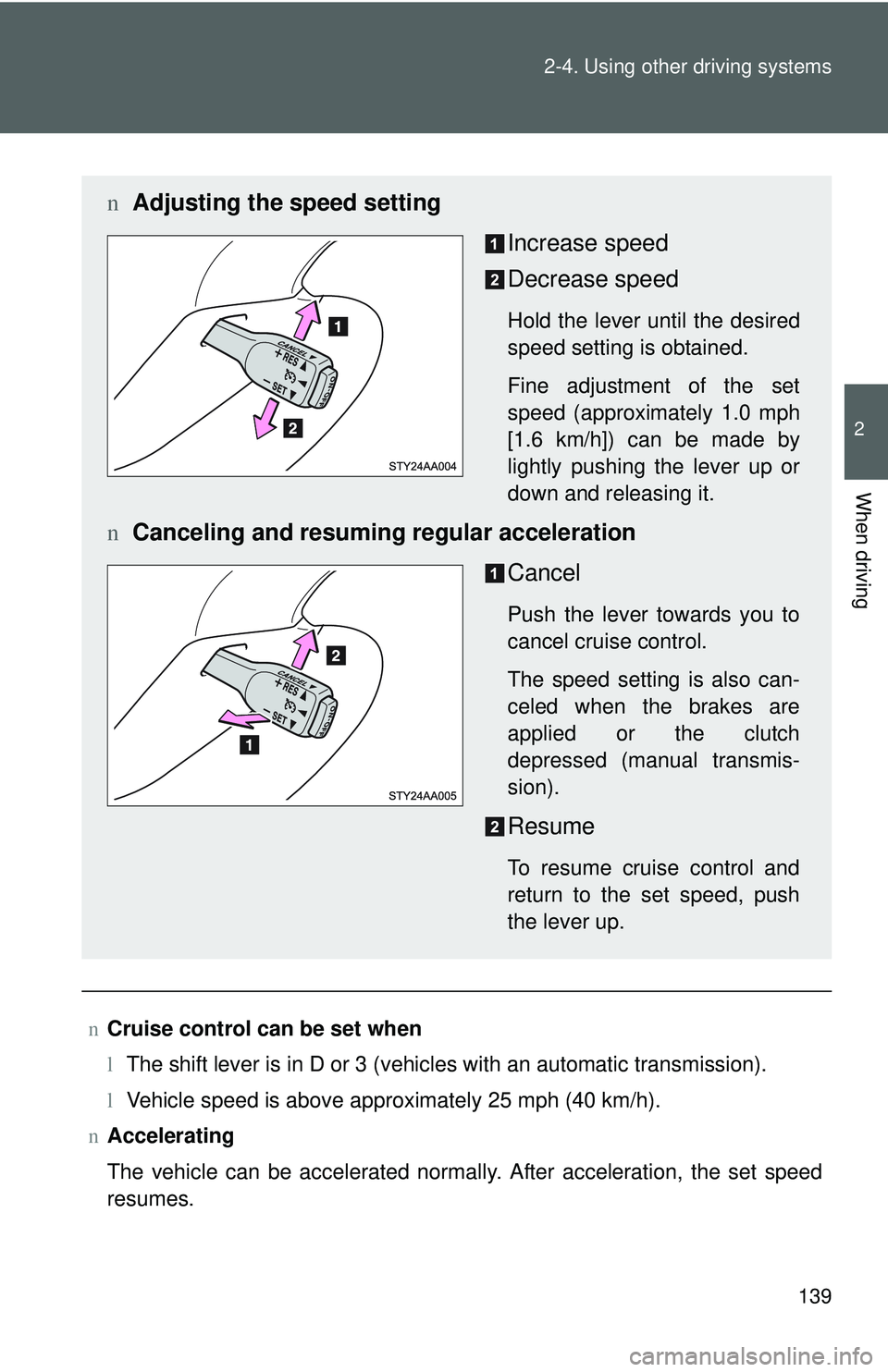
139
2-4. Using other
driving systems
2
When driving
nCruise control can be set when
lThe shift lever is in D or 3 (vehicles with an automatic transmission).
l Vehicle speed is above approximately 25 mph (40 km/h).
n Accelerating
The vehicle can be accelerated normally. After acceleration, the set speed
resumes.
n Adjusting the speed setting
Increase speed
Decrease speed
Hold the lever until the desired
speed setting is obtained.
Fine adjustment of the set
speed (approximately 1.0 mph
[1.6 km/h]) can be made by
lightly pushing the lever up or
down and releasing it.
nCanceling and resuming regular acceleration
Cancel
Push the lever towards you to
cancel cruise control.
The speed setting is also can-
celed when the brakes are
applied or the clutch
depressed (manual transmis-
sion).
Resume
To resume cruise control and
return to the set speed, push
the lever up.
Page 161 of 406
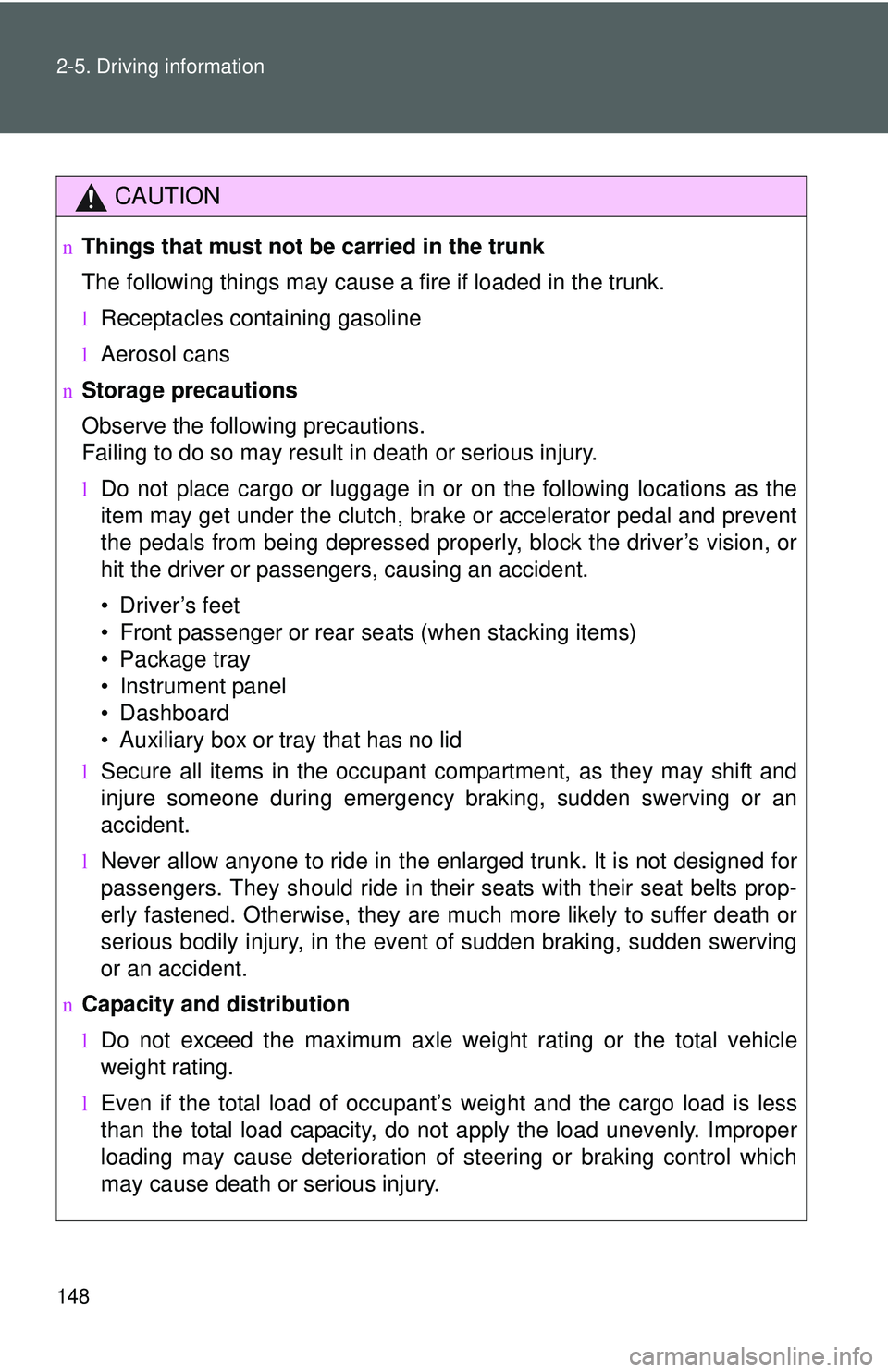
148 2-5. Driving information
CAUTION
nThings that must not be carried in the trunk
The following things may cause a fire if loaded in the trunk.
lReceptacles containing gasoline
lAerosol cans
nStorage precautions
Observe the following precautions.
Failing to do so may result in death or serious injury.
lDo not place cargo or luggage in or on the following locations as the
item may get under the clutch, brake or accelerator pedal and prevent
the pedals from being depressed properly, block the driver’s vision, or
hit the driver or passengers, causing an accident.
• Driver’s feet
• Front passenger or rear seats (when stacking items)
• Package tray
• Instrument panel
• Dashboard
• Auxiliary box or tray that has no lid
lSecure all items in the occupant compartment, as they may shift and
injure someone during emergency braking, sudden swerving or an
accident.
lNever allow anyone to ride in the enlarged trunk. It is not designed for
passengers. They should ride in their seats with their seat belts prop-
erly fastened. Otherwise, they are much more likely to suffer death or
serious bodily injury, in the event of sudden braking, sudden swerving
or an accident.
nCapacity and distribution
lDo not exceed the maximum axle weight rating or the total vehicle
weight rating.
lEven if the total load of occupant’s weight and the cargo load is less
than the total load capacity, do not apply the load unevenly. Improper
loading may cause deterioration of steering or braking control which
may cause death or serious injury.
Page 172 of 406
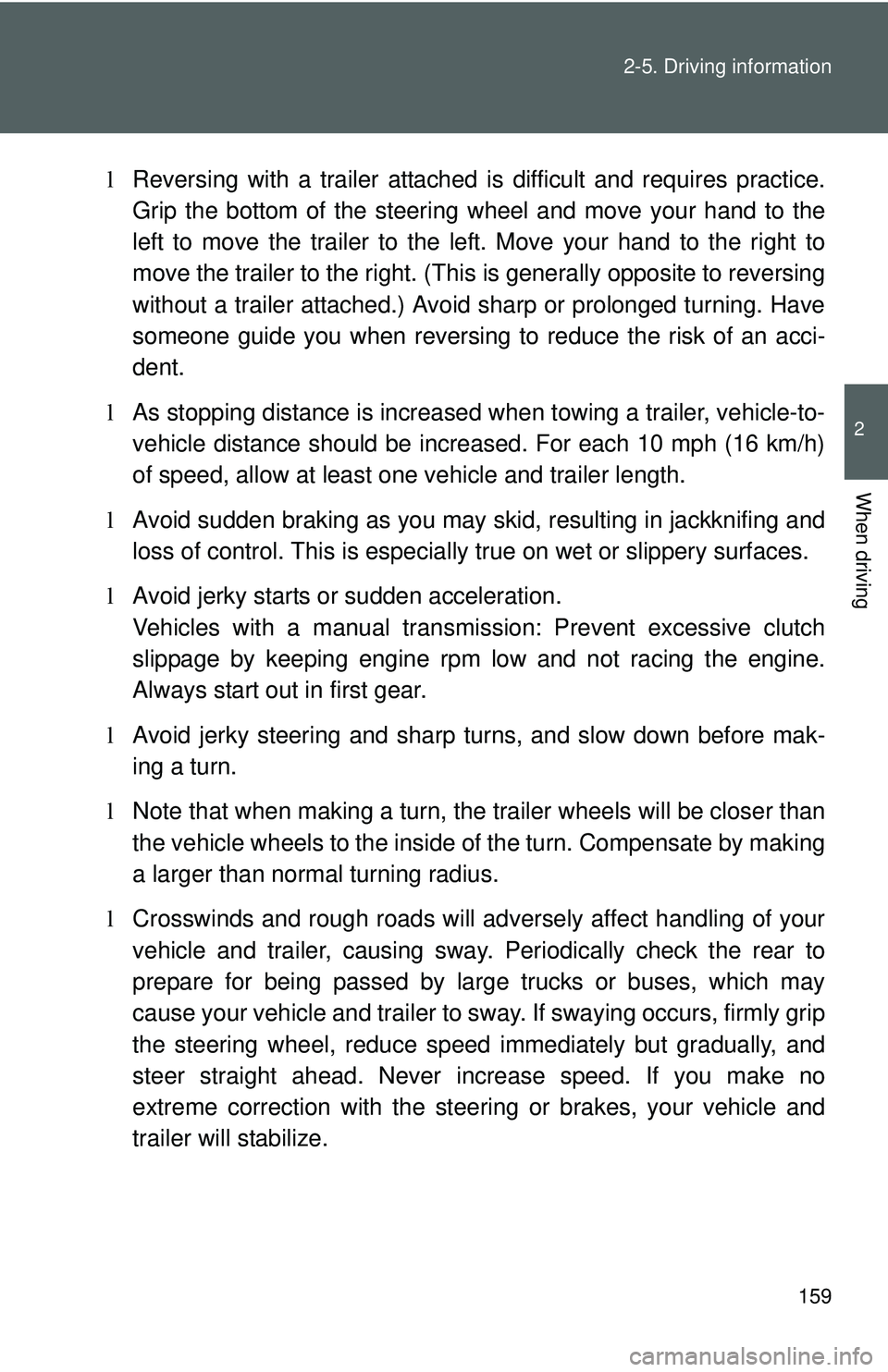
159
2-5. Driving information
2
When driving
l
Reversing with a trailer attached is difficult and requires practice.
Grip the bottom of the steering wheel and move your hand to the
left to move the trailer to the left. Move your hand to the right to
move the trailer to the right. (Thi s is generally opposite to reversing
without a trailer attached.) Avoid sharp or prolonged turning. Have
someone guide you when reversing to reduce the risk of an acci-
dent.
l As stopping distance is increased when towing a trailer, vehicle-to-
vehicle distance should be increased. For each 10 mph (16 km/h)
of speed, allow at least o ne vehicle and trailer length.
l Avoid sudden braking as you may skid, resulting in jackknifing and
loss of control. This is especiall y true on wet or slippery surfaces.
l Avoid jerky starts or sudden acceleration.
Vehicles with a manual transmis sion: Prevent excessive clutch
slippage by keeping engine rpm low and not racing the engine.
Always start out in first gear.
l Avoid jerky steering and sharp turns, and slow down before mak-
ing a turn.
l Note that when making a turn, th e trailer wheels will be closer than
the vehicle wheels to the inside of the turn. Compensate by making
a larger than normal turning radius.
l Crosswinds and rough roads will adversely affect handling of your
vehicle and trailer, causing sway . Periodically check the rear to
prepare for being passed by large trucks or buses, which may
cause your vehicle and trailer to sway. If swaying occurs, firmly grip
the steering wheel, reduce speed immediately but gradually, and
steer straight ahead. Never increase speed. If you make no
extreme correction with the stee ring or brakes, your vehicle and
trailer will stabilize.
Page 174 of 406

161
2-5. Driving information
2
When driving
l
When restarting after parking on a slope:
With the transmission in P (automatic transmission) or the
clutch pedal (manual transmission) depressed, start the
engine. On vehicles with an au tomatic transmission, be sure
to keep the brake pedal pressed.
Shift into a forward gear. If reversing, shift into R.
Release the parking brake (also brake pedal on vehicles with
an automatic transmission), and slowly pull or back away from
the wheel blocks. Stop and apply the brakes.
Have someone retrieve the blocks.
CAUTION
n To avoid an accident
lDo not exceed 45 mph (72 km/h) or posted towing speed limit, whichever
is lower. As instability (swaying) of the towing vehicle-trailer combination
increases as speed increases, exceeding 45 mph (72 km/h) may cause
loss of control.
l Slow down and downshift before descending steep or long downhill
grades. Do not make sudden downshifts.
l Avoid holding the brake pedal down too long or too frequently. This could
cause the brakes to overheat and result in reduced braking efficiency.
Page 239 of 406
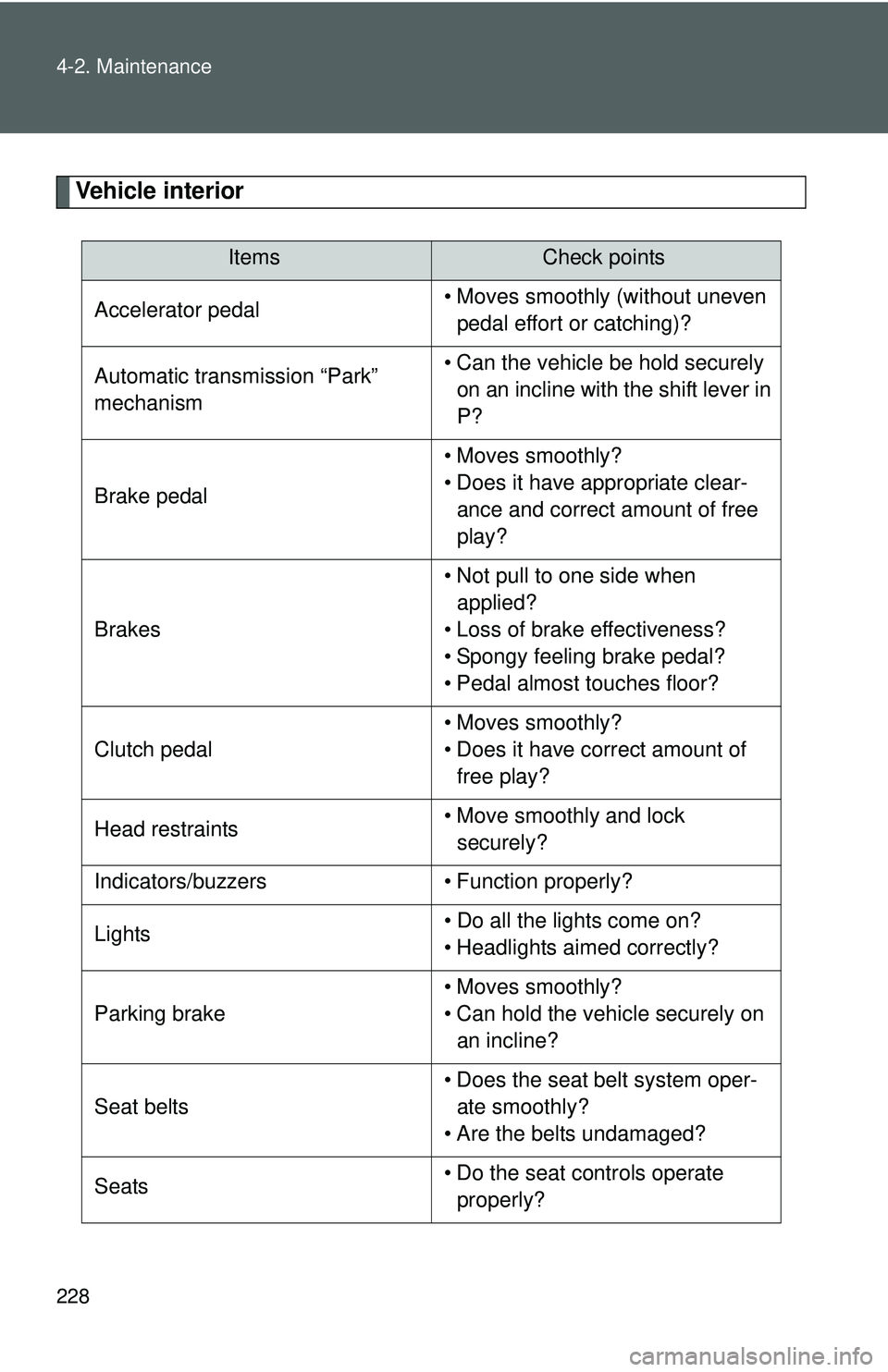
228 4-2. Maintenance
Vehicle interior
ItemsCheck points
Accelerator pedal • Moves smoothly (without uneven
pedal effort or catching)?
Automatic transmission “Park”
mechanism • Can the vehicle be hold securely
on an incline with the shift lever in
P?
Brake pedal • Moves smoothly?
• Does it have appropriate clear-
ance and correct amount of free
play?
Brakes • Not pull to one side when
applied?
• Loss of brake effectiveness?
• Spongy feeling brake pedal?
• Pedal almost touches floor?
Clutch pedal • Moves smoothly?
• Does it have correct amount of
free play?
Head restraints • Move smoothly and lock
securely?
Indicators/buzzers • Function properly?
Lights • Do all the lights come on?
• Headlights aimed correctly?
Parking brake • Moves smoothly?
• Can hold the vehicle securely on
an incline?
Seat belts • Does the seat belt system oper-
ate smoothly?
• Are the belts undamaged?
Seats • Do the seat controls operate
properly?
Page 354 of 406
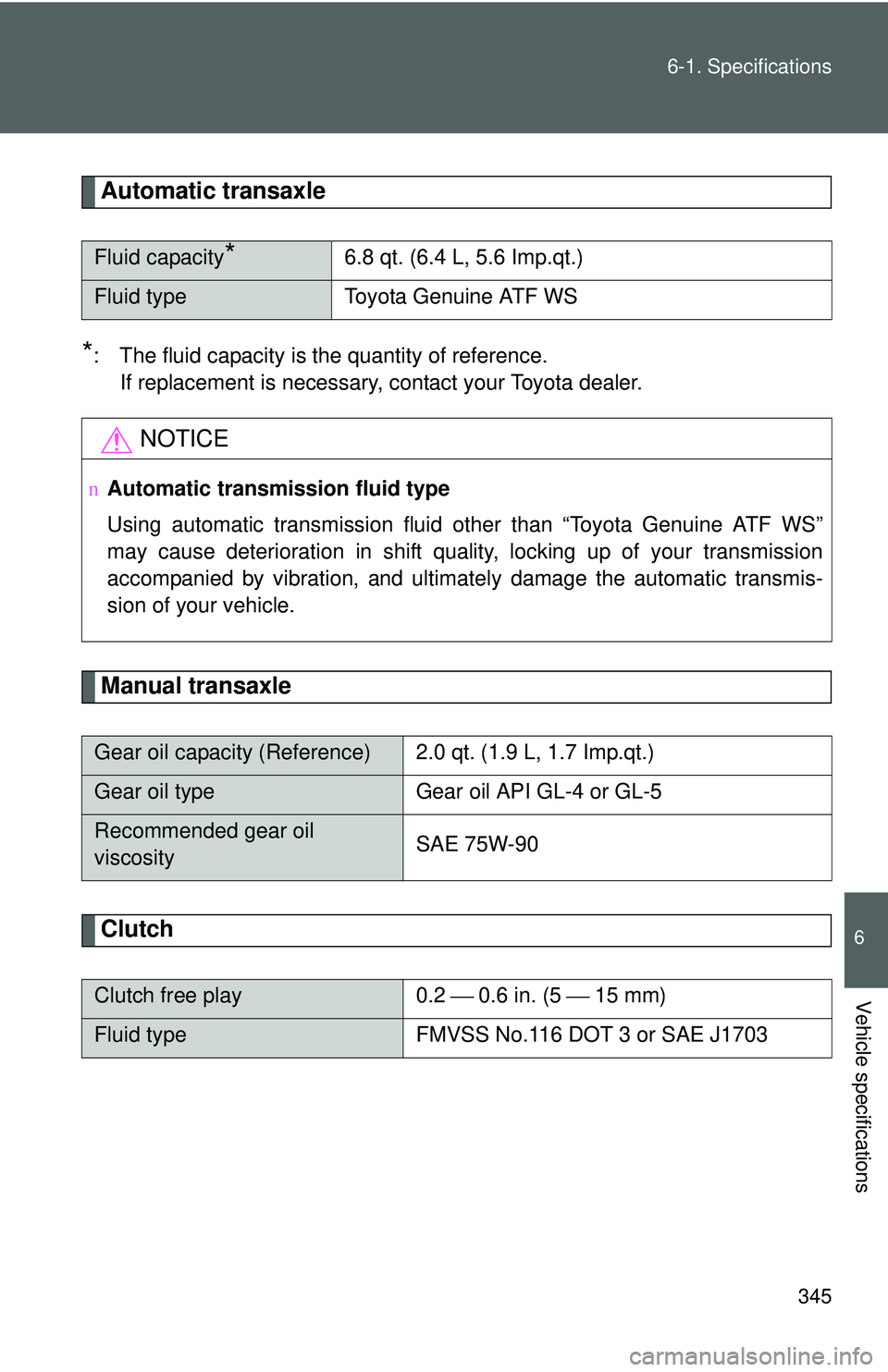
345
6-1. Specifications
6
Vehicle specifications
Automatic transaxle
*: The fluid capacity is the quantity of reference.
If replacement is necessary, contact your Toyota dealer.
Manual transaxle
Clutch
Fluid capacity*6.8 qt. (6.4 L, 5.6 Imp.qt.)
Fluid type Toyota Genuine ATF WS
NOTICE
nAutomatic transmission fluid type
Using automatic transmission fluid other than “Toyota Genuine ATF WS”
may cause deterioration in shift quality, locking up of your transmission
accompanied by vibration, and ultimately damage the automatic transmis-
sion of your vehicle.
Gear oil capacity (Reference) 2.0 qt. (1.9 L, 1.7 Imp.qt.)
Gear oil type Gear oil API GL-4 or GL-5
Recommended gear oil
viscosity SAE 75W-90
Clutch free play
0.2 ⎯ 0.6 in. (5 ⎯ 15 mm)
Fluid type FMVSS No.116 DOT 3 or SAE J1703
Page 392 of 406
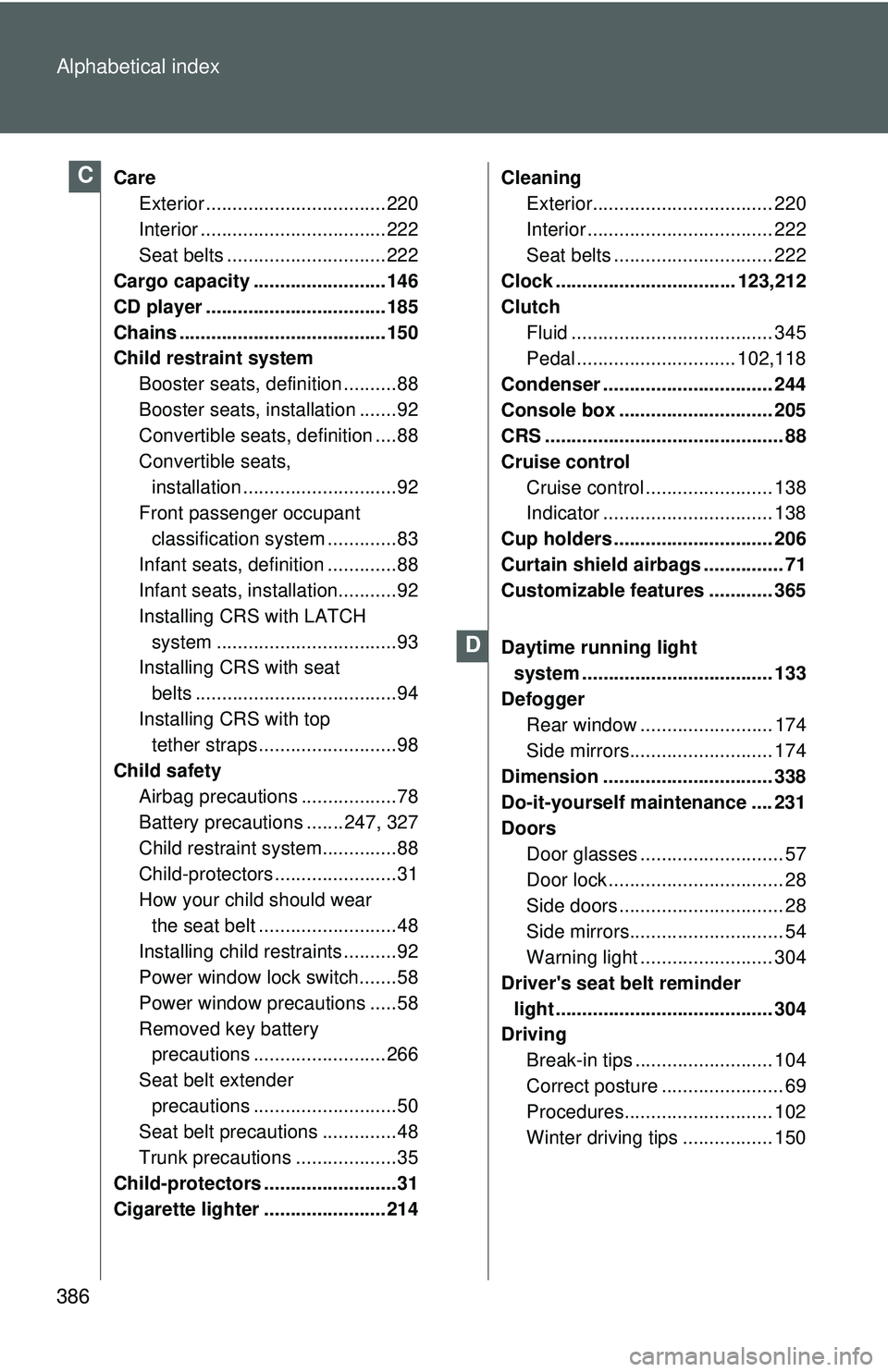
386 Alphabetical index
CareExterior .................................. 220
Interior ................................... 222
Seat belts .............................. 222
Cargo capacity ......................... 146
CD player .................................. 185
Chains ....................................... 150
Child restraint system
Booster seats, definition ..........88
Booster seats, installation .......92
Convertible seats, definition ....88
Convertible seats, installation .............................92
Front passenger occupant
classification system .............83
Infant seats, definition .............88
Infant seats, installation...........92
Installing CRS with LATCH system ..................................93
Installing CRS with seat
belts ......................................94
Installing CRS with top tether straps ..........................98
Child safety Airbag precautions ..................78
Battery precautions ....... 247, 327
Child restraint syst em..............88
Child-protectors .......................31
How your child should wear the seat belt ..........................48
Installing child restraints ..........92
Power window lock switch.......58
Power window precautions .....58
Removed key battery precautions ......................... 266
Seat belt extender precautions ...........................50
Seat belt precautions ..............48
Trunk precautions ...................35
Child-protectors .........................31
Cigarette lighter ....................... 214 Cleaning
Exterior.................................. 220
Interior ................................... 222
Seat belts .............................. 222
Clock .................................. 123,212
Clutch
Fluid ...................................... 345
Pedal .............................. 102,118
Condenser ................................ 244
Console box ............................. 205
CRS ............................................. 88
Cruise control Cruise control ........................ 138
Indicator ................................ 138
Cup holders .............................. 206
Curtain shield airbags ............... 71
Customizable features ............ 365
Daytime running light system .................................... 133
Defogger Rear window ......................... 174
Side mirrors........................... 174
Dimension ................................ 338
Do-it-yourself maintenance .... 231
Doors Door glasses ........................... 57
Door lock ................................. 28
Side doors ............................... 28
Side mirrors............................. 54
Warning light ......................... 304
Driver's seat belt reminder light ......................................... 304
Driving
Break-in tips .......................... 104
Correct posture ....................... 69
Procedures............................ 102
Winter driving tips ................. 150C
D
Page 393 of 406
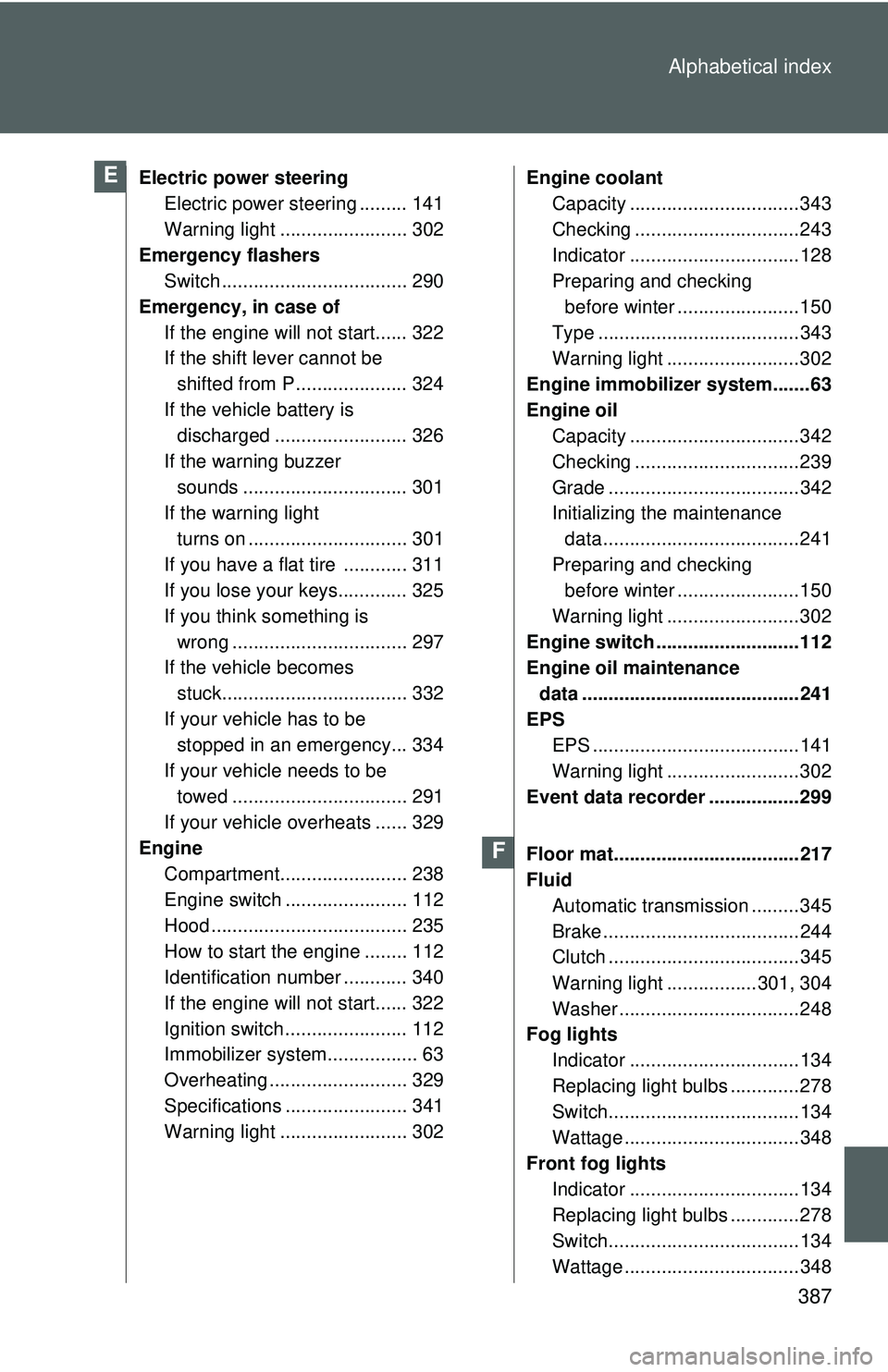
387
Alphabetical index
Electric power steering
Electric power steering ......... 141
Warning light ........................ 302
Emergency flashers Switch ................................... 290
Emergency, in case of If the engine will not start...... 322
If the shift lever cannot be shifted from P ..................... 324
If the vehicle battery is discharged ......................... 326
If the warning buzzer sounds ............................... 301
If the warning light
turns on .............................. 301
If you have a flat tire ............ 311
If you lose your keys............. 325
If you think something is wrong ................................. 297
If the vehicle becomes
stuck................................... 332
If your vehicle has to be stopped in an emergency... 334
If your vehicle needs to be towed ................................. 291
If your vehicle overheats ...... 329
Engine Compartment........................ 238
Engine switch ....................... 112
Hood ..................................... 235
How to start the engine ........ 112
Identification number ............ 340
If the engine will not start...... 322
Ignition switch ....................... 112
Immobilizer system................. 63
Overheating .......................... 329
Specifications ....................... 341
Warning light ........................ 302 Engine coolant
Capacity ................................343
Checking ...............................243
Indicator ................................128
Preparing and checking
before winter .......................150
Type ......................................343
Warning light .........................302
Engine immobilizer system.......63
Engine oil Capacity ................................342
Checking ...............................239
Grade ....................................342
Initializing the maintenance
data .....................................241
Preparing and checking before winter .......................150
Warning light .........................302
Engine switch ...........................112
Engine oil maintenance data .........................................241
EPS EPS .......................................141
Warning light .........................302
Event data recorder .................299
Floor mat...................................217
Fluid Automatic transmission .........345
Brake .....................................244
Clutch ....................................345
Warning light .................301, 304
Washer ..................................248
Fog lights
Indicator ................................134
Replacing light bulbs .............278
Switch....................................134
Wattage .................................348
Front fog lights Indicator ................................134
Replacing light bulbs .............278
Switch....................................134
Wattage .................................348E
F